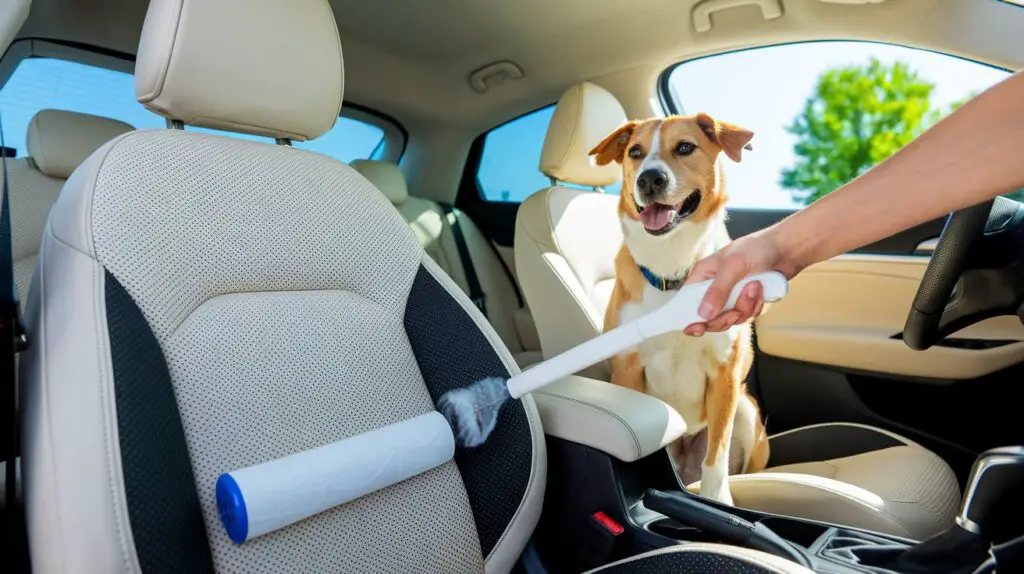
Keeping your car upholstery clean is essential for both aesthetic reasons and maintaining the vehicle’s value. Effective Ways to Remove Pet Hair from Car Upholstery are crucial for pet owners.
Pet hair, however, poses a unique challenge to its fan base. It can embed itself into the fabric, become airborne, trigger allergies, and generally ruin an otherwise tidy car interior. We all can relate to this.
This comprehensive guide outlines effective strategies to remove pet hair from your car and maintain a clean environment for both you and your furry friends.
Pets bring joy and companionship, but they also bring along their shedding fur, which can quickly turn your car into a hairy mess.
Once embedded in upholstery, pet hair can be challenging to remove, necessitating a strategic approach.
This guide will cover the most effective methods for removing pet hair, additional tools and techniques to assist you, preventative measures to minimize hair, and some lesser-known but beneficial tips.
Contents
Most Effective Methods for Removing Pet Hair
The most effective methods for removing pet hair, in my view, include using a rubber-bristle brush or lint roller to pick up hair from car upholstery, using a vacuum cleaner with a pet hair attachment, and regularly grooming your pet to minimize shedding.
Dampening a rubber glove and running it over surfaces can also help attract and remove stubborn pet hair.
Vacuum Cleaners with Specialized Attachments
Vacuum cleaners with specialized attachments are designed to provide enhanced cleaning capabilities beyond just the standard floor cleaning.
These attachments can include crevice tools for reaching tight spaces, dusting brushes for furniture and shelves, upholstery tools for fabrics, and even pet hair removal tools designed specifically to pick up pet hair and dander from car seats and upholstery.
Types of Vacuum Attachments Suitable for Pet Hair
Using a standard vacuum cleaner might not be enough to tackle pet hair. Specialized attachments can significantly enhance a vacuum’s effectiveness.
- Pet Hair Brush Attachments: These attachments often feature rubber bristles or rotating brushes that can lift and pull hair from the fabric. The rubber helps attract the hair due to static electricity, making it easier to remove.
- Crevice Tools: These narrow attachments are perfect for getting into tight spots where hair gathers, such as between seats or along the edges of the door.
- Upholstery Tools: Wider attachments with a flat surface and sometimes fabric strips are designed to agitate and lift hair from upholstery surfaces.
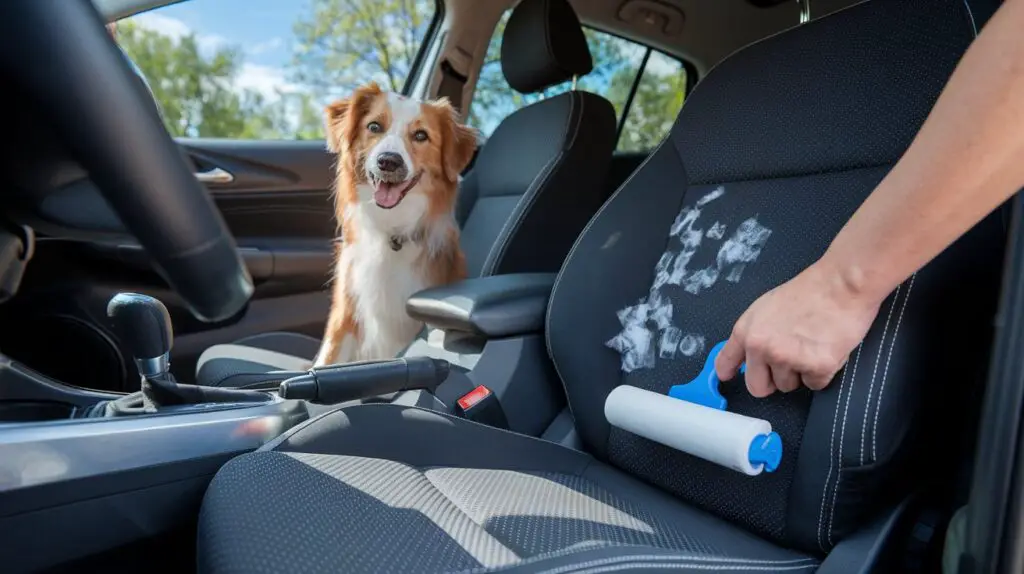
Techniques for Optimal Vacuuming Results
To achieve the best results with your vacuum cleaner:
- Regular Vacuuming Routine: Make it a habit to vacuum your car weekly, especially if your pet frequently travels with you. This prevents hair from embedding deeply into the fabric.
- Crosshatch Pattern: vacuum in a crisscross pattern. This method ensures that you approach the hair from multiple angles, helping to dislodge and lift it from the fibers.
- Adjust Suction Power: Use the highest suction setting your vacuum allows for stubborn areas. However, be cautious with more delicate materials to avoid damage
Rubber Gloves and Squeegee
Rubber gloves and a squeegee are useful tools for cleaning the upholstery inside a car.
The rubber gloves protect your hands while scrubbing, and the squeegee helps remove excess water and dirt from the fabric seats and carpets, leaving them clean and streak-free.
How Rubber Materials Attract Pet Hair
Rubber is a fantastic material for removing pet hair because of its ability to generate static electricity.
When you rub rubber against fabric, it creates a charge that attracts pet hair, making it easier to gather and remove.
A Step-by-Step Guide to Effectively Using Gloves and Squeegees
- Wear Rubber Gloves: Put on a pair of rubber gloves, and slightly dampen them with water. It adds a bit of grip and enhances the static effect.
- Rub Over Upholstery: Use firm, sweeping motions across the upholstery surface. You should see hair clumping together, making it simple to pick up and dispose of.
- Use a Squeegee: For larger areas or more stubborn patches of hair, a rubber squeegee can be highly effective. Apply a similar technique by dragging the squeegee across the surface to collect hair.
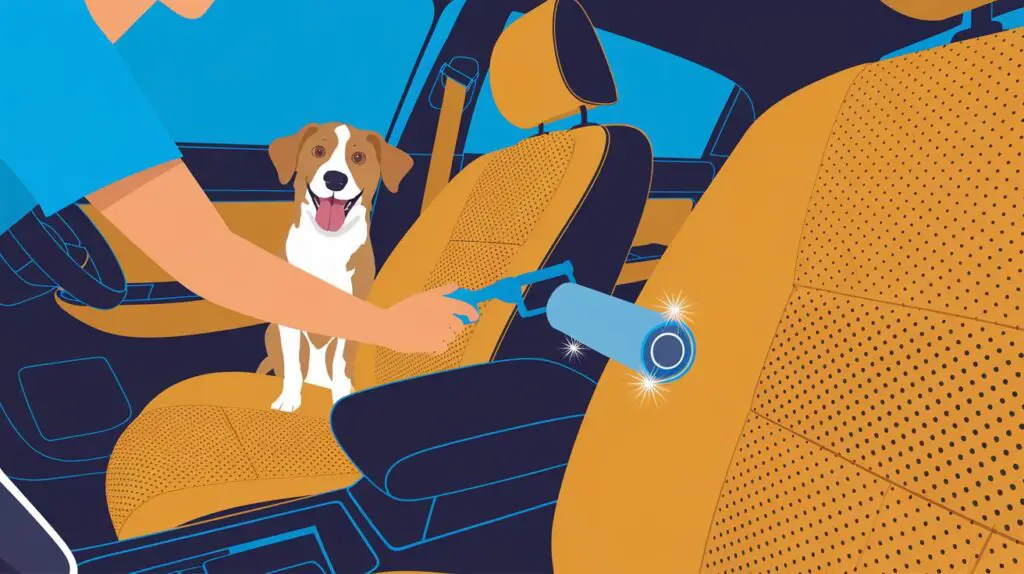
Additional Tools and Techniques
Lint Rollers and Sticky Tape
These tools are perfect for quickly removing pet hair from car upholstery. Their sticky adhesive picks up and traps hair and small debris.
Best Practices for Using Lint Rollers on Upholstery
Lint rollers are convenient for quick clean-ups and work well on flat surfaces.
- Roll in One Direction: Instead of back-and-forth motions, roll in a single direction to lift hair without pushing it deeper into the fabric.
- Replace Sheets Frequently: Ensure the roller is sticky enough to capture hair effectively. Replace the sheets as soon as they become full.
Advantages and Limitations of Sticky Tape Methods
- Advantages: Sticky tape can be a lifesaver when you need to quickly clean small areas. It’s also great for capturing hair that’s clinging to tight spots.
- Limitations: Not ideal for large areas due to the time and effort involved. Additionally, excessive use can leave adhesive residue on surfaces.
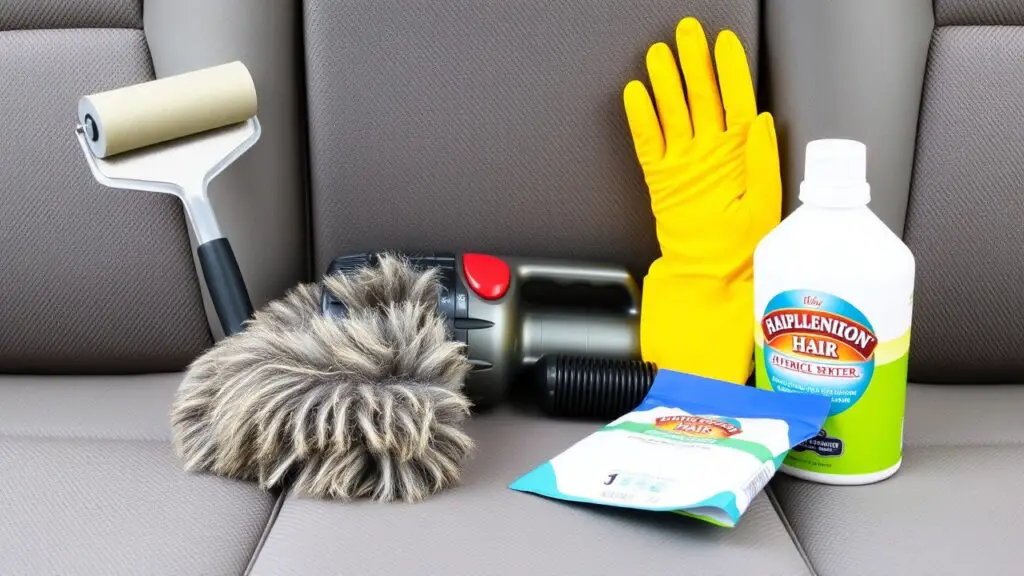
Fabric Softener Solutions
Fabric softener solutions are liquid or sheet-based products used in the laundry process to soften clothes, reduce static cling, and add a pleasant fragrance.
These solutions work by coating fabric fibers and lubricating them to make the clothes feel softer and more pliable.
Fabric softeners are typically added during the rinse cycle of a washing.
Preparing a Fabric Softener Spray for Loosening Hair
to have a simple solution to help loosen pet hair from upholstery,
- Mixing the Solution: Combine one part liquid fabric softener with three parts water in a spray bottle. Shake well to mix.
Application Process and Precautions
- Lightly Mist Upholstery: Spray the solution lightly over the areas with pet hair. Avoid soaking the fabric as this can lead to mildew or water stains.
- Let it Sit: Allow the solution to sit for a few minutes. The fabric softener helps relax the fibers and loosen the hair.
- Wipe with a Cloth: Use a clean, damp microfiber cloth to wipe the area. The hair should come off more easily.
Preventative Measures
Regular Grooming of Pets
- Benefits of Consistent Grooming in Reducing SheddingRegular grooming significantly reduces the amount of loose hair your pet sheds. This not only keeps your car cleaner but also promotes healthier skin and fur for your pet.
- Recommended Grooming Tools and Techniques
- Brushes and Combs: Choose grooming tools that are appropriate for your pet’s coat type. Slicker brushes, de-shedding tools, and combs can help remove loose fur before it ends up in your car.
- Bathing: Regular baths can help control shedding. Use a pet-friendly shampoo and thoroughly rinse to avoid skin irritation.
Use of Car Seat Covers and Protectors
Types of Covers Available for Pet Owners
Investing in car seat covers can save you a lot of hassle. Here are some options:
- Waterproof Covers: These protect against hair, dirt, and moisture, making them ideal for pet owners.
- Hammock-Style Covers: These attach to the front and back headrests, providing full coverage for the back seat area and preventing pets from accessing the front seat.
Installation Tips for Maximum Protection
- Secure Fit: Ensure the covers fit snugly and are anchored correctly to prevent them from slipping. Look for covers with adjustable straps and seat anchors.
- Ease of Cleaning: Choose machine-washable covers for convenience. Regular cleaning will help maintain a fresh interior.

Least Important but Useful Tips
DIY Home Remedies
Baking Soda and Vinegar Mixtures for Cleaning Upholstery
Baking soda and vinegar can be used to freshen up car upholstery and remove odors.
- Sprinkle Baking Soda: Lightly sprinkle baking soda over the seats and let it sit for 15-20 minutes to absorb odors.
- Vacuum: Vacuum the seats to remove the baking soda along with any loose hair.
- Vinegar Spray: Mix equal parts vinegar and water in a spray bottle. Lightly mist the upholstery to neutralize any lingering odors.
Homemade Anti-Static Sprays to Repel Hair
- Create a Spray: Mix one part fabric softener with ten parts water. Spray lightly over upholstery to reduce static cling and repel hair.
Professional Cleaning Services
When to Consider Professional Detailing
If your car’s interior is heavily soiled or you lack the time to clean it yourself, consider professional detailing.
Professionals have the tools and expertise to thoroughly clean and restore your car’s upholstery.
Evaluating Cost Versus Convenience
- Cost-Effectiveness: While professional cleaning can be expensive, it may be worth the cost if it saves you time and produces better results than DIY methods.
- Convenience: Scheduling regular professional cleanings can help maintain your car’s cleanliness with minimal effort on your part.
Conclusion
Maintaining a pet-friendly vehicle requires a combination of effective cleaning strategies and preventative measures.
Regular vacuuming with specialized attachments, using rubber gloves and squeegees, and employing fabric softener solutions have significantly reduced pet hair in the car for me and my team
Additionally, grooming your pets regularly and using protective covers can prevent hair accumulation.
Whether you opt for DIY methods or professional services, these strategies will help keep your car clean and enjoyable for both you and your furry companions.
Embrace these practices, and you’ll find a harmonious balance between pet ownership and vehicle cleanliness.
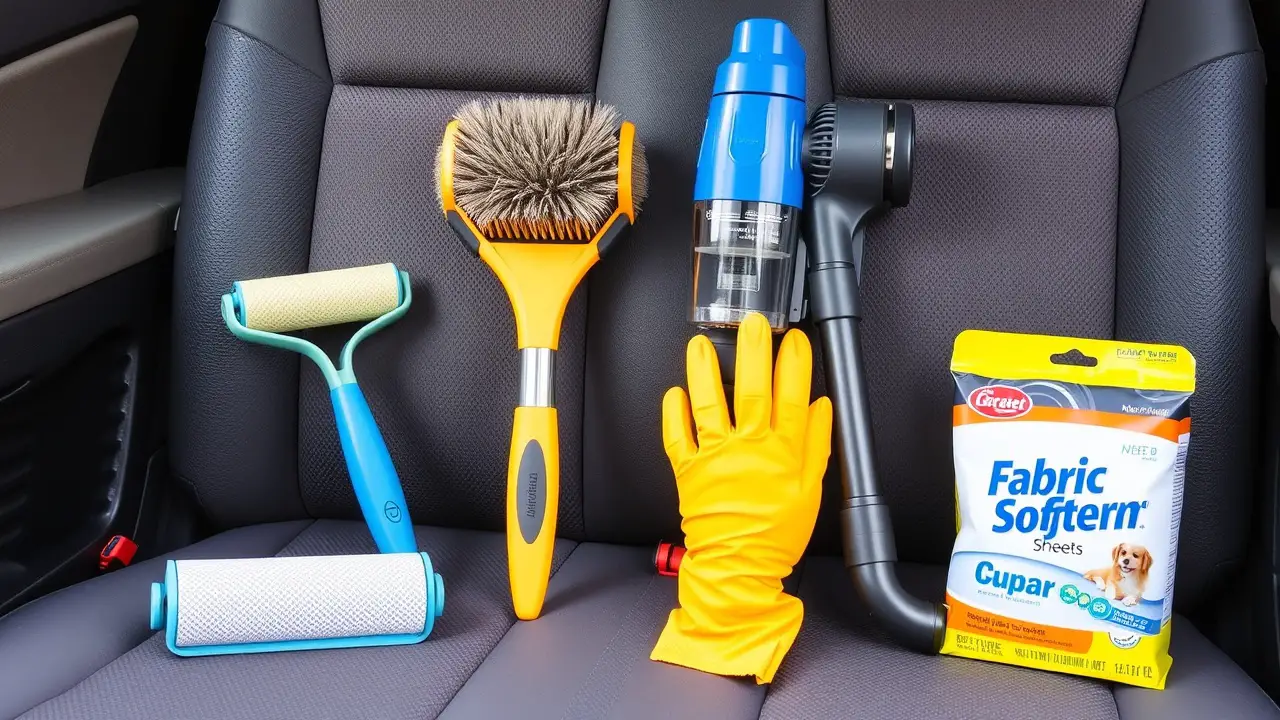

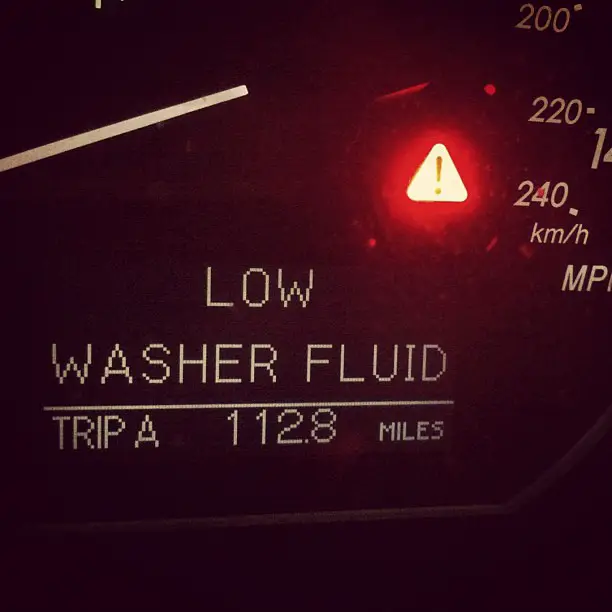
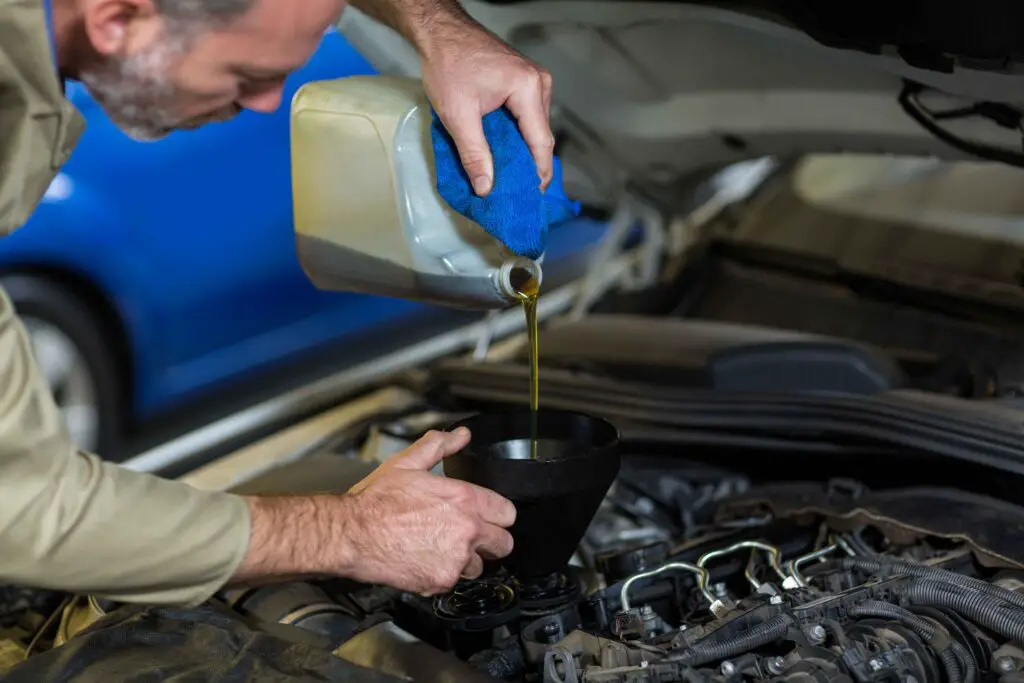
Leave a Reply